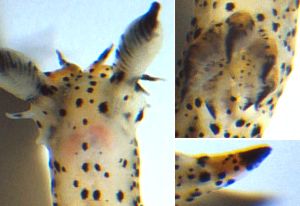
Polycera abei
(Baba,1960)
Order: NUDIBRANCHIA
Suborder: DORIDINA
Superfamily: ANADORIDOIDEA
Family: Polyceridae
Subfamily: Polycerinae
DISTRIBUTION
Described from Japan. Recorded here from Hong Kong, eastern Australia.
PHOTO
UPPER & LOWER RIGHT: Yat Chap Mo, Hong Kong, 2m, 3 February 1985, AM C145665. Photo: Brian Darvell.
LOWER LEFT: HK135/2-5, BEPHK231, Hong Kong, April 1983. AM C139202. Photo: B.E.Picton.
From original description: "Grows to about 15mm. Body smooth above (non-tuberculate), no pallial ridge on each side. Velar papillae 6, long and digitiform. General body colour translucent yellowish white, with black spots interspersed among the orange ones. Rhinophores and velar papillae black; gills yellowish white with black tips."


Rudman, W.B., 2001 (July 10) Polycera abei (Baba,1960). [In] Sea Slug Forum. Australian Museum, Sydney. Available from http://www.seaslugforum.net/find/polyabei
Related messages
Polycera abei ? from Kalimantan Timur
August 2, 2004
From: Hisashi Ito

Dear Bill,
The attached photo was taken at Is. Sangalaki Is, East Kalimantan (Kalimantan Timur), Indonesia on 4th March, 2004. The dive site is called Manta Run and the area was sandy bottom of 20m depth.
I was reading discussions on Polycera capensis, and wondering whether the creature is it or not.
Hisashi Ito
kuro@neko.ac
Ito, H., 2004 (Aug 2) Polycera abei ? from Kalimantan Timur. [Message in] Sea Slug Forum. Australian Museum, Sydney. Available from http://www.seaslugforum.net/find/12634Dear Hisashi,
This is an interesting photo. I think it is a colour form of Polycera abei, a species which appears to range in colour from specimens with no yellow, as in the original description, to animals with a uniform yellow background. Intermediates can be found with a few yellow spots on the body and yellow on the rhinophores, gills and mantle veil like in your specimen. I have not seen one with a black line around the mantle edge like in your photo, but considering the other variations, I don't think this would disqualify your animal from being the same species.
Your animal differs in colour from Polycera capensis and it also lacks the lateral papilla on each side alongside the gills. Some biologists consider this such a significant difference that they put species without this feature in a distinct genus Greilada [see Greilada elegans]. Your animal has a remarkable resemblance to another polycerid, Thecacera picta, but that animal has large lateral papillae alongside the gills and the rhinophores.
If anyone has photos I could add to the Forum showing the colour variation found in P. abei, they would be very welcome
Best wishes,
Bill Rudman
